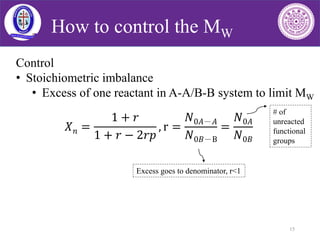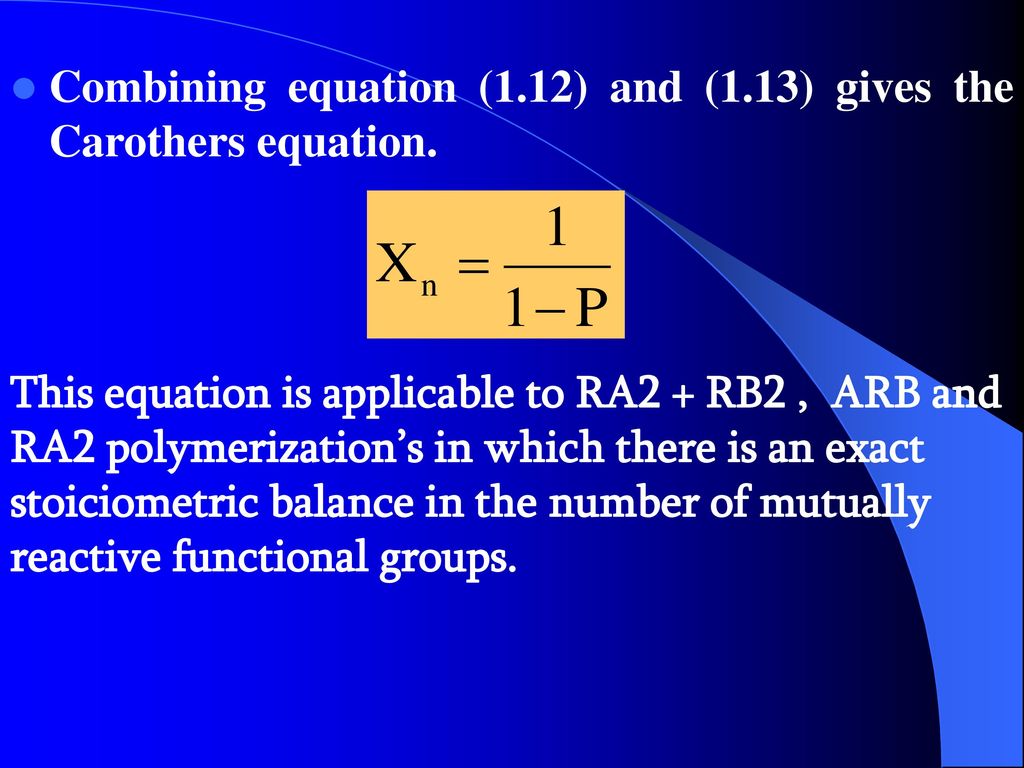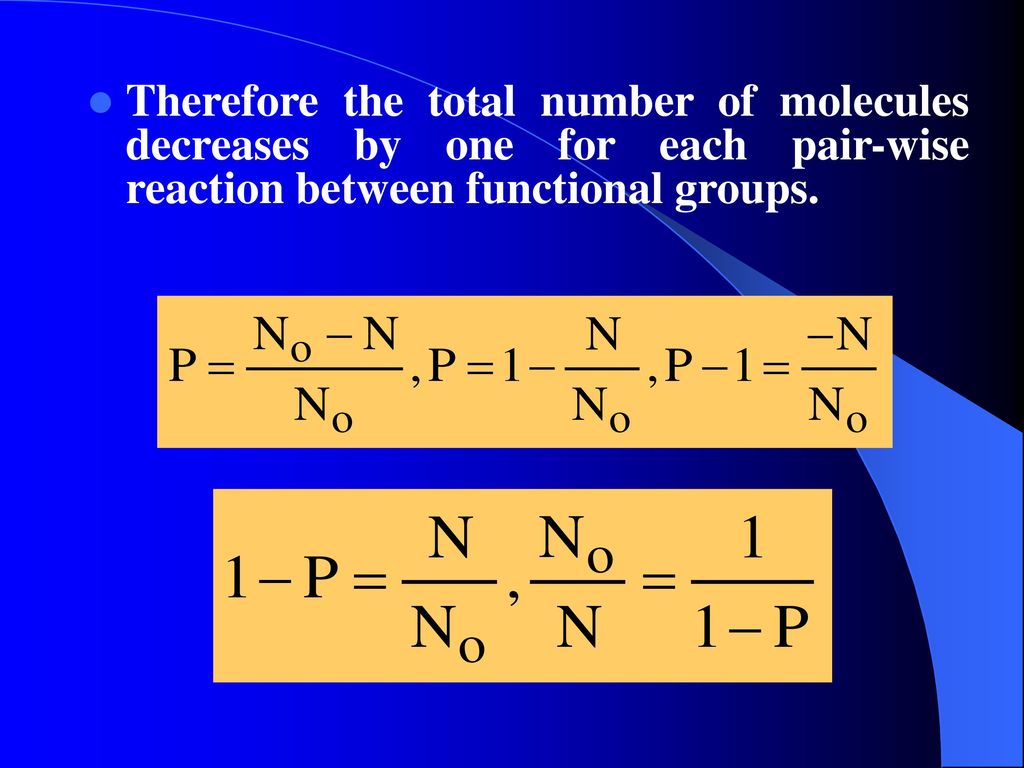carothers equation polymer
There are several versions of this equation proposed by Wallace Carothers who invented nylon in 1935. Carothers equation and Monomer See more Nylon.

Step Growth Polymerization The Carothers Equation And The Flory Schulz Distribution Montoguequiz Com
In step-growth polymerization the Carothers equation or Carothers equation gives the degree of polymerization X n for a given fractional monomer conversion p.

. Nylon 66 nylon 6-6 nylon 66 or nylon 66 is a type of polyamide or nylon. Segmented and Block Copolymers from Step Condensation Methods 7 Crosslinking and Branching. X n 1 r 1.
A few days after starting work he wrote that he intended. Carothers equation In step-growth polymerization the Carothers equation or Carothers equation gives the number-average degree of polymerization Xn for a given fractional monomer conversion p. You may be surprised really how high extent of reaction needs to be in order to get polymers of any significant length especially as your reactant ratio deviates more greatly from 1.
There are several versions of this equation proposed by Wallace Carothers who invented nylon in 1935. 12 Practical Tips 8 Steps to a Clean Balance and 5 Solutions to Keep It Clean. There are several versions of this equation proposed by Wallace Carothers who invented nylon in 1935.
In polycondensations the number-average degree of polymerization DP can be expressed as DP 1 r 1 r 2 rp where p is the extent of the polymerization and r is the stoichiometric ratio between the comonomers. Carothers equation In step-growth polymerization the Carothers equation or Carothers equation gives the degree of polymerization Xn for a given fractional monomer conversion p. The simplest case refers to the formation of a strictly linear polymer.
A Word on MWD for Nonlinear Polymerizations 9. Derivation of the Carothers equation for molecular mass as a function of the extent of the reaction p and reactant ratio r. Weighing the right way Correct Test Weight Handling Guide.
Carothers believed that polymers were molecules hooked together end-to-end in long chains by ordinary bonds. Condensation polymerization offers the possibility of constructing polymer molecules of accurately known structure. In the case of non-stoichiometric ratios of two or more different functional groups Florys and Stockmayers statistical approaches give more accurate results.
Carothers equation and Nylon See more Nylon 66. Two monomers in equimolar quantities. In step-growth polymerization in order to achieve a high degree of polymerization and hence molecular weight X n a high fractional monomer conversion p is required according to Carothers equation For example a monomer conversion of p 99 would be required to achieve X n 100.
After integration and substitution from Carothers equation the final form is the following Carothers. Two monomers in equimolar quantities. Carothers equation is used to illustrate the extent of reaction for linear polycondensation or polyaddition polymerization reactions.
Nylon is a generic designation for a family of synthetic polymers based on aliphatic or semi-aromatic polyamides. The Carothers Equation High Molecular weights are hard to get this way If there are N omolecules at time 0 and N remaining at time t then the amount reacted is N 0 -N and we can define p as the conversion or fraction reacted then as P N o N N o or N N o 1 P If DP is the average degree of polymerization N 0. Step-growth polymerization vs chain growth to be covered in more detail later in the course extent of reaction number-average degree of polymerization.
However the Carothers equation is limited to branched systems describing the degree of polymerization only at the onset of cross-linking. Carothers equation and Nylon 66. Network Formation and Gelation.
This equation was originally proposed by Carothers and is often referred to as. The Carothers equation is an effective method for calculating the degree of polymerization for stoichiometrically balanced reactions. In step-growth polymerization the Carothers equation or Carothers equation gives the degree of polymerization Xn for a given fractional monomer conversion p.
The simplest case refers to the formation of a strictly linear polymer by the reaction usually by condensation of two monomers in equimolar quantities. Trending posts and videos related to. Carothers equation is applicable only to stoichiometric mixtures of addition monomers or if only one type of functional group undergoes polymerization as it is the case with chain growth.
In polycondensations the number-average degree of polymer- ization DP can be expressed as DP 1 r1 r 2rp where p is the extent of the polymerization and r is the stoichiometric ratio between the comonomers. If X n describes the number of average chain length and P describes the extent of the reaction then starting with N 0 as the number of molecules at the beginning of the polymerization after some time has elapsed N is the number of molecules left in the. Contents 1 Linear polymers.
The question is Design an alkyd resin from phthalic anhydride pentaerythritol and soya oil MW 878 gmol for which pc 102 according to Carothers equation. Furthermore the synthesis follows Carothers equation DP 1 1-p which describes the degree of polymerization DP as a function of conversion p the. Polymer Organic How to determine stoichiometry in polymers.
In his pioneering work from 1929 carothers described a vision for polycondensation that expressed the requirement for reactive monomeric functional groups to form a new bond through the elimination of a small molecule or condensate12 the early work explored the reversible nature of polycondensation reactions and strategies to circumvent the. An example is the synthesis of nylon-66 whose formula is -NH-CH 2 6-NH-CO-CH 2 4-CO- n from one mole of hexamethylenediamine H 2 NCH 2 6 NH 2 and one mole of adipic acid HOOC-CH 2. 1 This equation reaches an asymptotic value at p p 1 and requires in practice a final evaluation at p 099.
Other Polymers of Interest Obtained by Step-Growth. N In step-growth polymerization the Carothers Equation Carothers Equation gives the degree of polymerization Xn for a given fractional monomer conversion p Odain 2004. To test his theory he proposed to create polymers by using well-known chemical reactions to join together many small molecules.
This equation is based on general stochastic insights and gives the degree of polymerization or number average chain length ie xn for a given A or equivalently B FG conversion p with r 1 ignoring intramolecular reactions. The best Carothers equation images and discussions of April 2022. Pn Approach 8 Network Formation.

Spring 2007 Chap 8 Polycondensation Reactions Classification By

Kinetics And Thermodynamics In P

Dodt Oxidative Polymerization Data Dashed Line Plotted Against The Download Scientific Diagram

Chapter 9 Kinetics Of Chain And Step Growth Polymerization

Step Growth Polymerization Wikiwand

Introduction To Polymers Lecture 5 4 Step Growth Molecular Weight Part 1 Youtube

Kinetics And Thermodynamics In P

Carothers Theory Carothers Developed A Simple Method Of Analysis For Predicting The Molar Mass Of Polymer Prepared By Step Polymerization He Recognized Ppt Download

Introduction To Polymers Lecture 5 5 Step Growth Molecular Weight Part 2 Youtube

Lecture 2 The Carothers Equation Youtube

Carothers Theory Carothers Developed A Simple Method Of Analysis For Predicting The Molar Mass Of Polymer Prepared By Step Polymerization He Recognized Ppt Download

Carothers Theory L Carothers Developed A Simple Method

Macromolecular Chemistry Lecture 5 Step Growth Chain Growth

Polymer Chemistry Malcolm P Stevens Ppt Download

Degree Of Polymerization Of Polymers Materials Today

Carothers Theory Carothers Developed A Simple Method Of Analysis For Predicting The Molar Mass Of Polymer Prepared By Step Polymerization He Recognized Ppt Download


Comments
Post a Comment